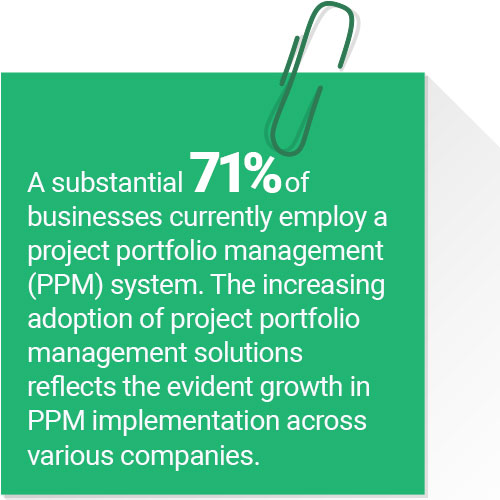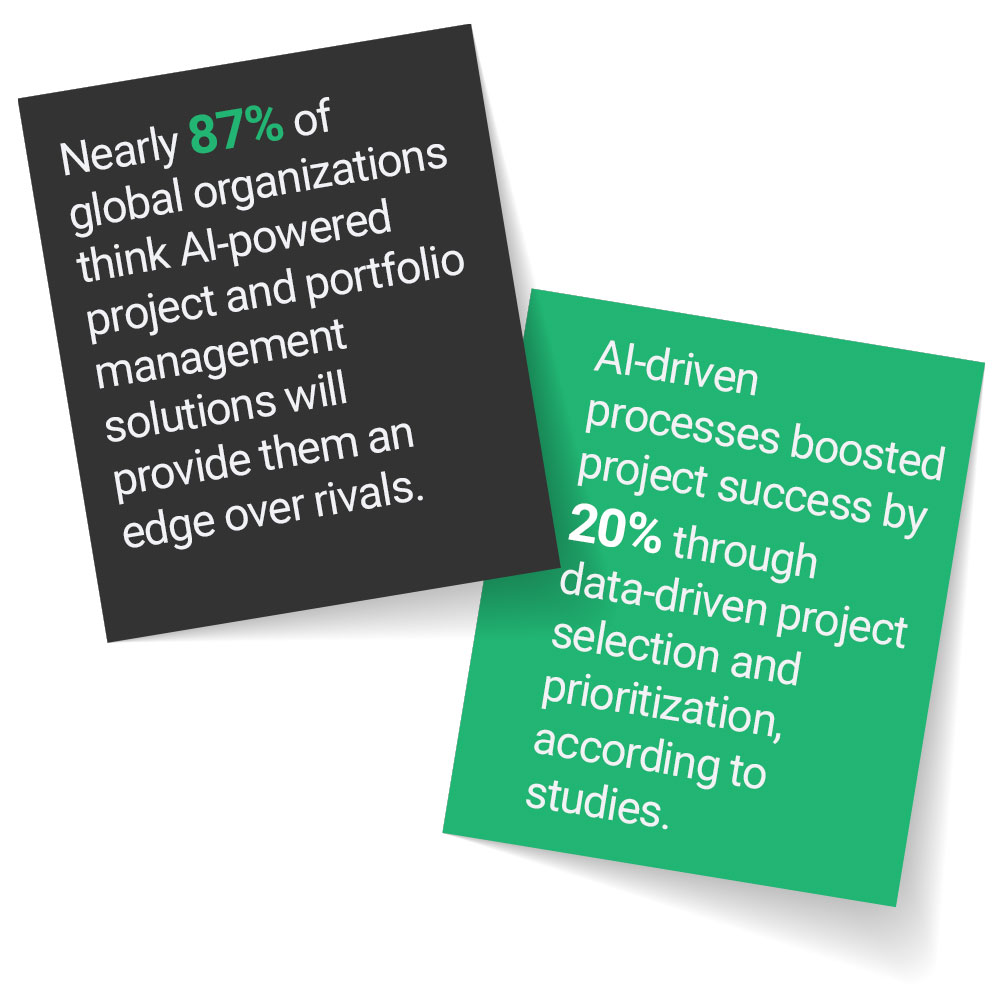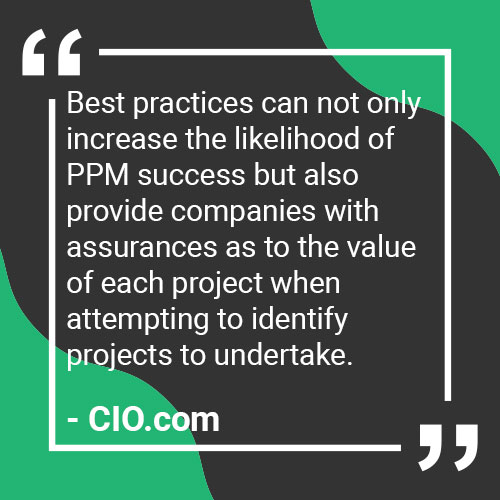
Managing a single project can be challenging, but juggling a portfolio of projects demands a robust, multi-faceted approach. Your team requires an effective structure, while stakeholders demand a clear view of outcomes. So, how do you help your project leaders achieve them? Successful project and portfolio management requires masterful coordination and resource allocation. To maximize capital, utilize resources efficiently, and keep all projects and programs on track, project portfolio management (PPM) solutions become essential. PPM standardizes, manages, and captures the execution of project and operational activities and resources. So, are you prepared to enable your project leaders to enhance their strategic skills, employ effective prioritization, and transform their projects and portfolios into masterpieces of productivity?
Integrating modern technology solutions like artificial intelligence predicts the future of your projects, automates mundane tasks, and gives you insights you hadn't even considered. That's AI for you in the world of PPM. AI's capability to process vast amounts of data at unprecedented speed enables a more dynamic and responsive approach to PPM, where decisions are not just reactive but proactive, anticipating shifts in market trends, resource availability, and project risks.
In this article, we will explore the concept of project and portfolio management, its importance, and the critical steps that should be included in the PPM process. We will also explore how AI reshapes project and portfolio management, real-world examples, and potential challenges and opportunities.
What is Project and Portfolio Management?
Project Portfolio Management (PPM) is a systematic process through which an organization assesses and executes its projects to ensure they align strategically with the company's goals. PPM offers executives, project managers, team members, and stakeholders a comprehensive perspective on their projects, illustrating how they contribute to the organization's overall directives and strategy. This insight aids in understanding the potential returns and risks associated with the projects.
The PPM framework categorizes projects into programs based on relevance and similarities. These programs and their respective projects must adhere to a portfolio strategy established by the project management office (PMO) to meet the overarching company objectives effectively. Consequently, PPM goes beyond merely aligning projects with business strategy; it serves as a mechanism for harmonizing an organization's approach to managing projects, encompassing all project policies and processes with its strategic goals.
According to the Project Management Institute (PMI), project and portfolio management is significant because it serves as a bridge between strategy and implementation. Your portfolio manager ensures that suitable projects are undertaken at the right time to maximize the company's investment, particularly in organizations with numerous internal projects.
In a business environment where project ideas can emerge spontaneously, project and portfolio management become essential for comprehending which projects will have the most significant beneficial impact on the company. This understanding allows project prioritization based on available time, funds, and resources. So, what kind of companies benefit from project and portfolio management? We have got you covered.
Industry-Based Use Cases
Project and portfolio management is a versatile solution applicable across industries, providing companies with the tools to enhance project management, mitigate risks, and align project activities with overarching strategic objectives. Therefore, project and portfolio management are necessary for any company to work on several projects simultaneously. Let’s look at the industries that benefit from PPM:
 IT (Information Technology): Information technology teams, often characterized by smaller, specialized talent pools and substantial budgets, can leverage AI-powered project and portfolio management solutions for resource profiling. This involves updating skills inventory to align with peak demand periods and utilizing data-driven forecasting to assign teams to value-driven projects. PPM enables IT teams to meet project demands successfully without overburdening or underutilizing their resources. AI algorithms enhance task scheduling efficiency by evaluating multiple elements, including the availability of resources, interdependencies, project prioritization, and constraints.
IT (Information Technology): Information technology teams, often characterized by smaller, specialized talent pools and substantial budgets, can leverage AI-powered project and portfolio management solutions for resource profiling. This involves updating skills inventory to align with peak demand periods and utilizing data-driven forecasting to assign teams to value-driven projects. PPM enables IT teams to meet project demands successfully without overburdening or underutilizing their resources. AI algorithms enhance task scheduling efficiency by evaluating multiple elements, including the availability of resources, interdependencies, project prioritization, and constraints.- Construction: Large construction projects, which may span months or even years, can face challenges like fluctuating project finances, evolving stakeholder needs, or the departure of key personnel. Predictive analytics-driven project and portfolio management prove invaluable in maintaining focus on overarching goals amidst project intricacies, helping construction teams adapt to changes efficiently and progress towards their objectives.
- Financial Services: Accuracy is paramount for financial services companies like credit unions, banks, and credit card firms. Modern PPM solutions are crucial in setting up performance thresholds, adapting to changing trends, and providing real-time metrics to meet project objectives in the dynamic financial services sector.
- Project Management Teams: With only 29% of companies completing projects on time, according to Wellingtone's State of Project Management report, project management teams can benefit from predictive analytics-enabled PPM solutions to minimize unforeseen delays, mitigate risks, and sequence projects for maximum success. Stakeholders gain enhanced visibility into project prioritization and better understand project value.
- Professional Services Teams: Using project and portfolio management, professional services teams of varying sizes can streamline project workflows and generate realistic budget estimates. Smaller companies with fewer projects and budgets and larger companies managing multiple simultaneous projects find value in standardized systems that expedite project completion while minimizing risks.
- Marketing Teams: Marketing teams dealing with diverse projects, such as market expansion or online market share acquisition, require effective prioritization aligned with overall business goals. PPM aids marketing teams in focusing on initiatives that propel business objectives forward, ensuring a strategic approach rather than isolated project management.
So, why are project and portfolio management critical for your organization’s project success? Can you succeed without a clear link between your organizational goals and project value? Undoubtedly, the answer is no. It is here that project and portfolio management play a critical role. Let’s understand the benefits of PPM for your organizational success.
Benefits of Project and Portfolio Management
Modern project and portfolio management promotes a holistic perspective, ensuring each project contributes meaningfully to the larger strategic vision. Therefore, decisions are no longer shrouded in subjectivity but based on robust data-driven frameworks. PPM also offers quantitative and qualitative analyses, encompassing risk assessments, resource availability, potential return on investment, and guided project selection and prioritization.

The benefits of adopting PPM are multifold:
- Increased profitability: Optimized resource utilization and improved strategic alignment have led to significant cost reductions and maximized ROI.
- Maximize resource utilization: Break free from resource silos and optimize talent allocation. PPM facilitates coordinated project scheduling, mitigating resource conflicts, and ensuring efficient organizational utilization.
- Elevated stakeholder confidence: Transparency and data-driven decision-making cultivate trust and buy-in from stakeholders, fostering a culture of collaboration and shared success.
- Boosted organizational agility: The ability to quickly adapt to changing priorities and market conditions provides a distinct competitive advantage in today's dynamic environment.
- Governance and oversight: Project and portfolio management establishes a natural governance model, providing a holistic overview of all projects. Furthermore, it allows for the creation of contingency plans and data-driven decision-making.
- Drive strategic alignment: It bridges the gap between company objectives and project execution. No more misdirected efforts: PPM ensures each initiative contributes tangibly to the overarching vision.
Although project and portfolio management is highly beneficial and leads companies toward success, traditional PPM is not free of challenges. Project activities intersect various business domains, involving multiple teams, functions, tools, and systems, which inherently raises the risk of problems affecting overall project management efficiency. Addressing these challenges is crucial for optimizing coordination and collaboration to ensure a seamless project and portfolio management process. Let’s take a deeper look at the challenges now.
Challenges of Traditional Project and Portfolio Management
 Ensuring Alignment with Organizational Goals: This requires diligent effort to match project portfolios with overarching objectives. As goals evolve, periodic reassessments become crucial. Addressing this requires establishing clear long-term goals through stakeholder collaboration and defining criteria for project acceptance or rejection based on alignment.
Ensuring Alignment with Organizational Goals: This requires diligent effort to match project portfolios with overarching objectives. As goals evolve, periodic reassessments become crucial. Addressing this requires establishing clear long-term goals through stakeholder collaboration and defining criteria for project acceptance or rejection based on alignment.
 Balancing Resources: Your managers must carefully allocate suitable projects to the right resources at the right time. Challenges include competing project demands, limited access to specific resources, and intermittent availability of resources.
Balancing Resources: Your managers must carefully allocate suitable projects to the right resources at the right time. Challenges include competing project demands, limited access to specific resources, and intermittent availability of resources.
 Forecasting Project Value Accurately: Some projects demand upfront investments before returns materialize. This means your forecasting must consider the potential rewards and risks involved. Therefore, you must carefully analyze project ideas, demands, and propositions to pick the most promising ones consistently.
Forecasting Project Value Accurately: Some projects demand upfront investments before returns materialize. This means your forecasting must consider the potential rewards and risks involved. Therefore, you must carefully analyze project ideas, demands, and propositions to pick the most promising ones consistently.
 Effective Risk Management: Market dynamics and uncertainties create challenges that require a comprehensive risk management strategy. Early risk identification, rigorous assessment, probability evaluation, and contingency planning are essential for successful risk management.
Effective Risk Management: Market dynamics and uncertainties create challenges that require a comprehensive risk management strategy. Early risk identification, rigorous assessment, probability evaluation, and contingency planning are essential for successful risk management.
 Adapting to Market Changes: The nature of project cycles and the possibility of sudden or rapid changes can make it difficult for organizations to adapt to market changes. Building flexibility into the strategic project and portfolio management process through short- and long-term plans is essential. Monitoring external factors, such as industry trends and customer feedback, enables quick responses to changing market conditions.
Adapting to Market Changes: The nature of project cycles and the possibility of sudden or rapid changes can make it difficult for organizations to adapt to market changes. Building flexibility into the strategic project and portfolio management process through short- and long-term plans is essential. Monitoring external factors, such as industry trends and customer feedback, enables quick responses to changing market conditions.
So, how do you overcome the challenges of traditional PPM methodologies? Modern technology solutions such as AI-powered predictive analytics play a critical role. Let’s explore the advantages of predictive analytics in project and portfolio management.
How Is Predictive Analytics Reshaping Project and Portfolio Management?
 As you overcome project complexities, you contemplate if there is any way to leverage technology to simplify processes, reduce risks, and enhance outcomes. Indeed, predictive analytics is the solution! How, you ask? A predictive intelligence solution scrutinizes project details such as timelines, resources, performance metrics, and documented risks along with their outcomes. After processing the extensive data, it identifies discernible patterns. For example, it determines that projects involving tight deadlines will likely exceed budget constraints. Empowered with this predictive capability, the AI system alerts project managers when a new project exhibits these risk attributes. Here are some benefits of AI-enabled project and portfolio management systems:
As you overcome project complexities, you contemplate if there is any way to leverage technology to simplify processes, reduce risks, and enhance outcomes. Indeed, predictive analytics is the solution! How, you ask? A predictive intelligence solution scrutinizes project details such as timelines, resources, performance metrics, and documented risks along with their outcomes. After processing the extensive data, it identifies discernible patterns. For example, it determines that projects involving tight deadlines will likely exceed budget constraints. Empowered with this predictive capability, the AI system alerts project managers when a new project exhibits these risk attributes. Here are some benefits of AI-enabled project and portfolio management systems:
- Enhanced efficiency: Predictive intelligence solutions can automate repetitive tasks such as data analysis, scheduling, and documentation. This automation allows your project managers and resources to concentrate on more strategic activities, boosting overall efficiency.
- Data-driven decision-making: Predictive project and portfolio management analytics can recognize patterns, risks, and opportunities within project data. This enables more accurate and proactive decision-making in PPM based on data-driven insights.
- Improved resource allocation: AI can optimize resource allocation by analyzing historical data, project requirements, and current resource availability, ensuring more efficient resource utilization.
- Enhanced risk management: AI-powered systems analyze historical data and patterns to provide early warnings and recommend mitigation strategies. This capability enhances risk management in PPM by offering proactive insights into potential issues.
Though AI-enabled project and portfolio management solutions look fascinating, you must know some best practices before implementing them.
Project and Portfolio Management Best Practices You Must Adhere to
 Follow these essential best practices to ensure optimal outcomes.
Follow these essential best practices to ensure optimal outcomes.
Define Business Goals and Strategies: Clearly articulate organizational goals and develop a business strategy aligned with the vision. Evaluate projects about business objectives to avoid losing focus.
Establish a Project Management Office (PMO): Form a dedicated unit, the PMO, to oversee project and portfolio management. Obtain support from senior executives to prevent interference from "pet projects" and ensure successful checks and balances.
Project and Resource Inventory: Conduct an inventory of current projects and resources. Evaluate projects for redundancies, identify potential cost-saving areas, and assess the availability of skilled employees for high-value projects.
Develop Project Evaluation Criteria: Collaborate with business leaders to create evaluation criteria for projects. Assess whether projects align with business goals, determine expected outcomes, and consider resource requirements. Ensure PMO approval for all project initiatives.
Risk Management Strategy: Integrate risk management as a standalone practice. Evaluate the inherent and potential risks to the portfolio, conducting assessments throughout a project's lifecycle. Keep stakeholders informed so they can accurately compare new initiatives against the overall portfolio.
Embracing the Future: The Path to Project and Portfolio Management Excellence!
Traversing the complex landscape of project and portfolio management demands a strategic blend of structure, foresight, and technological innovation. Adopting strategic project and portfolio management allows you to align your projects with strategic goals, optimize resource allocation, and enhance overall efficiency. The versatility of PPM is evident across various industries, from information technology and construction to financial services and marketing, demonstrating its universal applicability. While traditional project and portfolio management faces challenges such as aligning with evolving organizational goals and balancing resources, integrating modern technologies, particularly AI-powered predictive analytics, offers a transformative solution.
Predictive analytics streamlines processes, enhances efficiency, empowers data-driven decision-making, improves resource allocation, and strengthens risk management. If you want to implement one such powerful solution, look no further than TrueProject. TrueProject, a predictive intelligence solution for project health and performance, provides in-depth insight into your portfolio's probability of success. The solution proactively spots issues, addresses unmet KPIs, and quickly identifies systemic problems. You can instantly view where systemic issues are creating project delays, failures, and losing money.
Running practical projects is the only way to innovate, change, and enhance your organization’s competitive position. So, protect your portfolio of projects and your career with TrueProject. Your mastery of project and portfolio management is not just a strategic necessity but a visionary investment in the future of project management excellence.
 About the Author:
About the Author:
Nivedita Gopalakrishna is a content marketing specialist within the TrueProject Marketing team with extensive experience in blog writing and website content creation across diverse industries. Nivedita’s proficiency in crafting engaging blog posts and informative website content is a testament to her years of experience. Beyond her prowess in written communication, Nivedita has the knack for creating visually appealing static graphics that have played a pivotal role in expanding TrueProject's marketing efforts. Through thoughtful design choices, she has helped convey the essence of the brand and captivate audiences effectively. Outside the professional sphere, Nivedita is a trained classical singer and a fitness enthusiast, embodying creativity and wellness in and out of the office.
Endnotes:
- Tucci, Linda “Project portfolio management: A beginner's guide.” CIO Strategy. TechTarget, February 2023. https://www.techtarget.com/searchcio/definition/PPM-project-and-portfolio-management
- Hurley, Alex. “Project Portfolio Management Process.” Planview, (n.d.). https://www.planview.com/resources/guide/project-management-office-ppm-best-practices/project-portfolio-management-process/
- “Project Portfolio Management.” ProjectManager, (n.d.). https://www.projectmanager.com/guides/project-portfolio-management
- Verma, Eshna. “What Is Project Portfolio Management (PPM)?” Simplilearn, November 14, 2022. https://www.simplilearn.com/project-portfolio-management-an-overview-rar88-article
- “What is project portfolio management? Aligning projects to business goals.” CIO, June 24, 2021. https://www.cio.com/article/219965/what-is-project-portfolio-management-aligning-projects-to-business-goals.html
- “What Is Project Portfolio Management (PPM)?” Wrike, (n.d.). https://www.wrike.com/project-management-guide/faq/what-is-project-portfolio-management-ppm/
- “The 5 Biggest Challenges in Strategic Portfolio Management.” Uppwise, December 12, 2022. https://www.uppwise.com/2022/12/26/challenges-strategic-portfolio-management/
- “Navigating the AI Revolution: A Roadmap to Integrating AI into Project and Portfolio Management.” PPM Express, June 16, 2023. https://ppm.express/blog/integrating-ai-into-ppm/#:~:text=The%20benefits%20of%20AI%20for%20PPM,-AI%20technology%20offers&text=Let's%20start%20by%20exploring%20the,focus%20on%20more%20strategic%20activities



